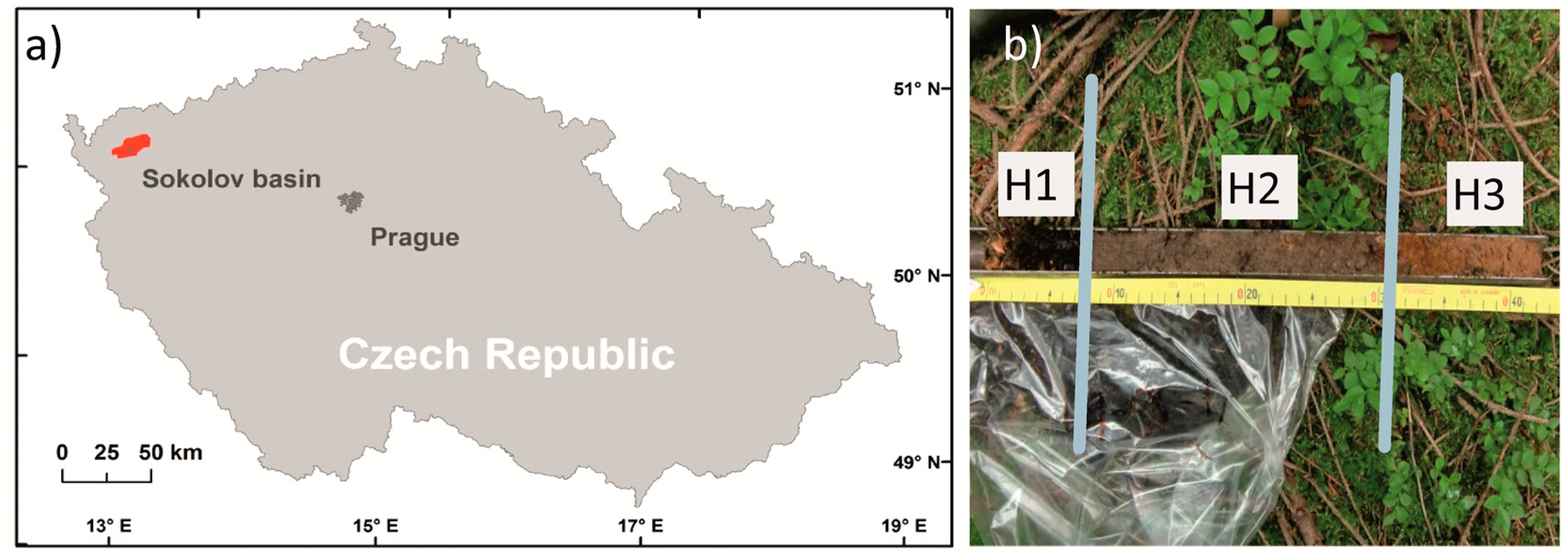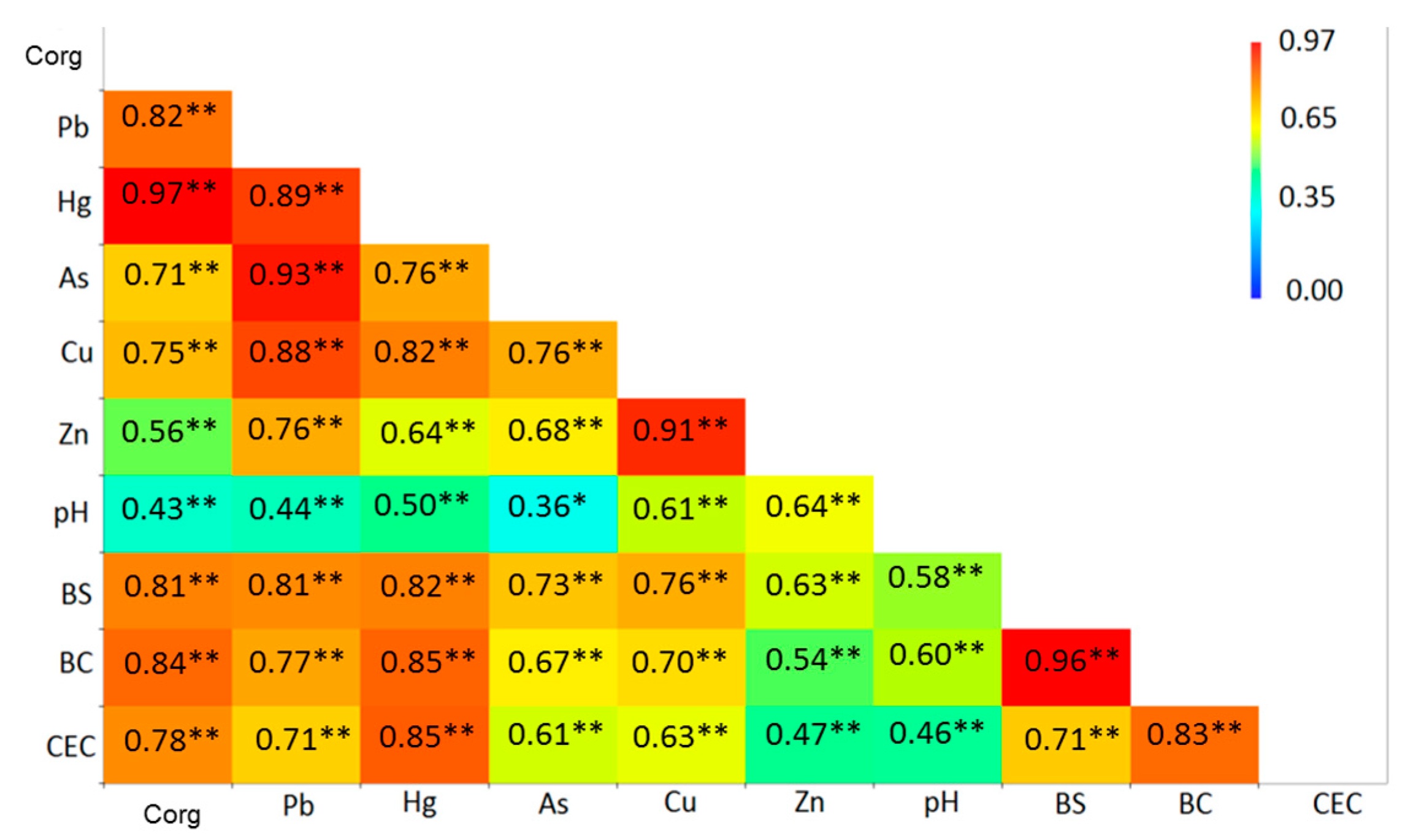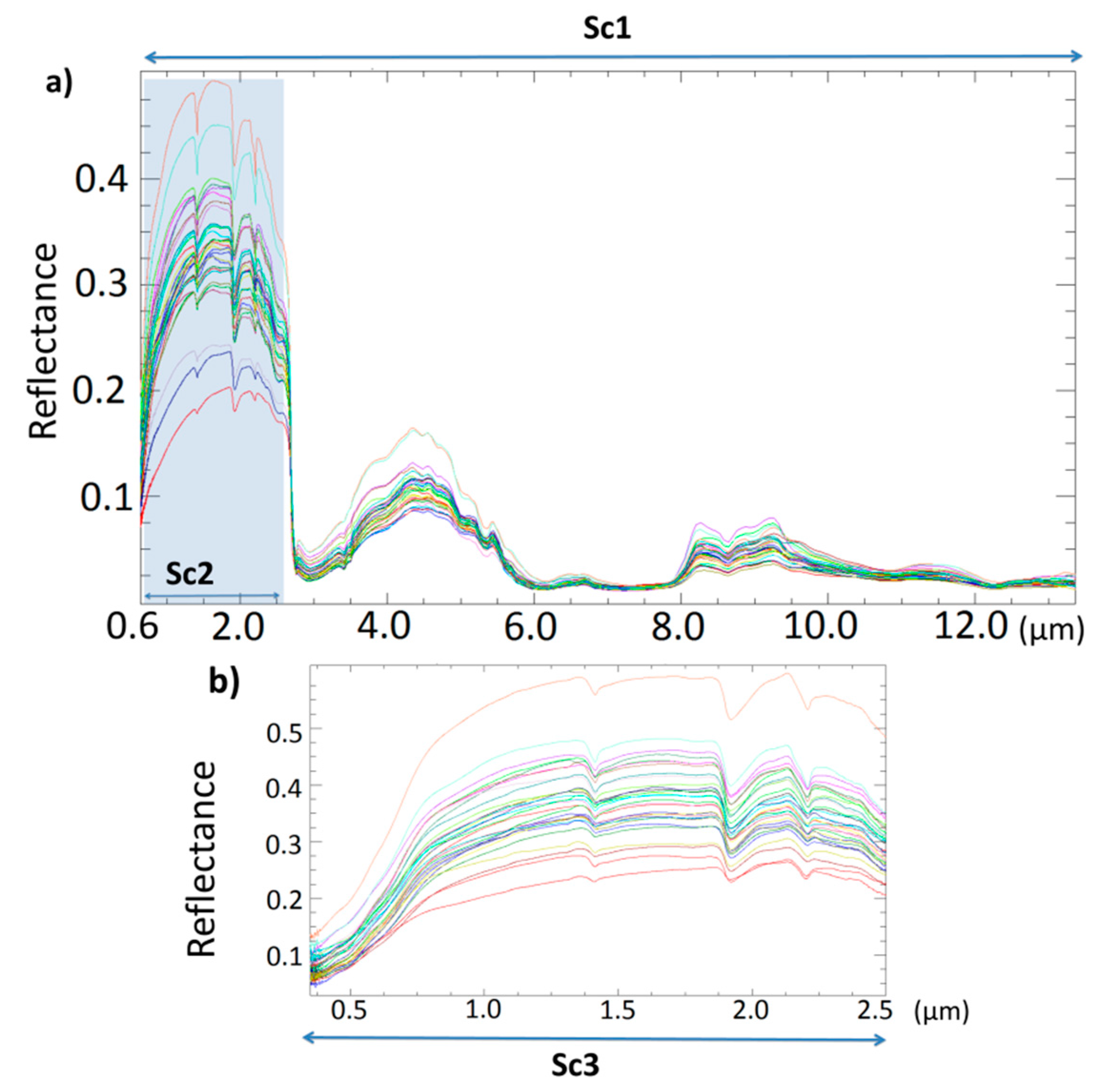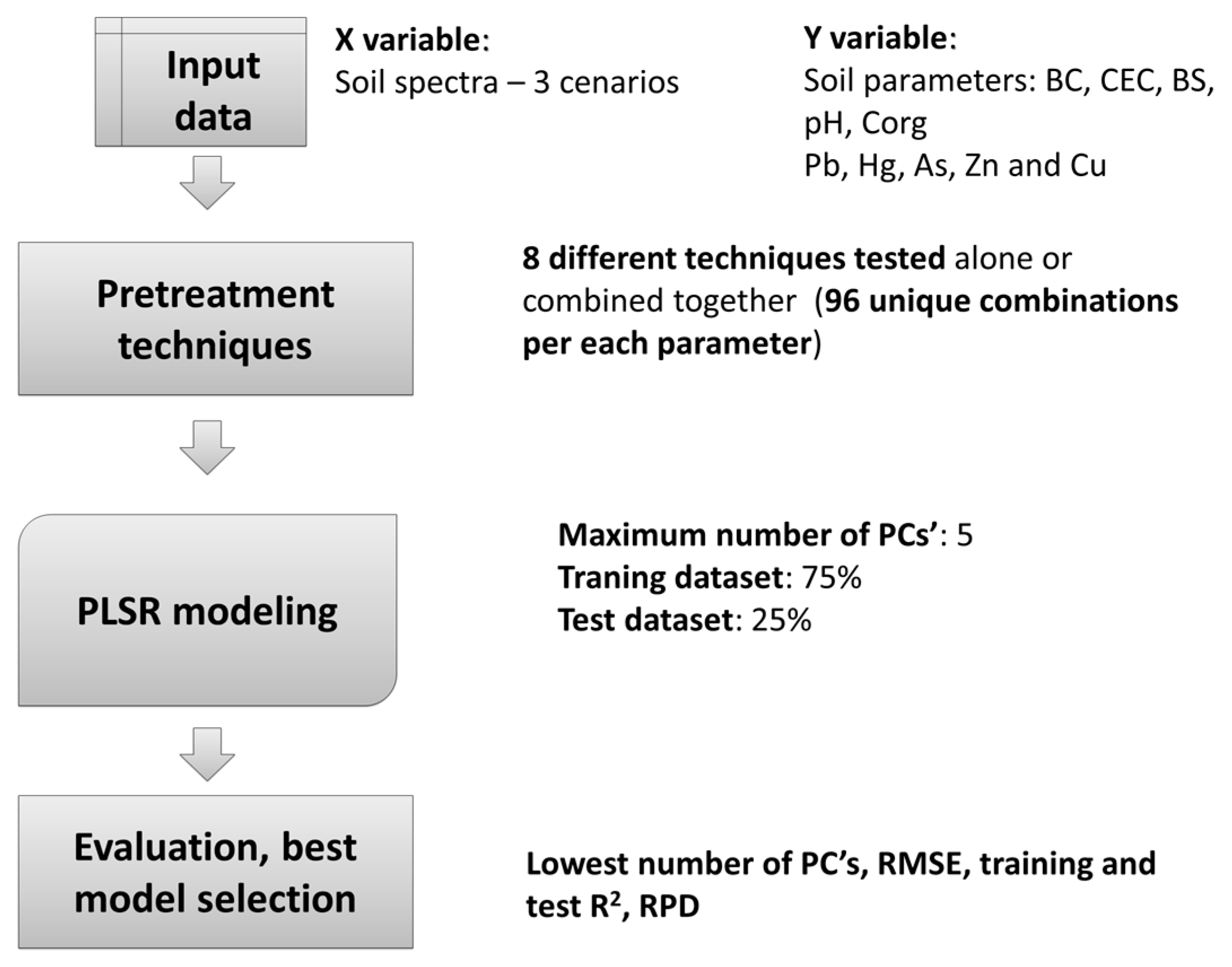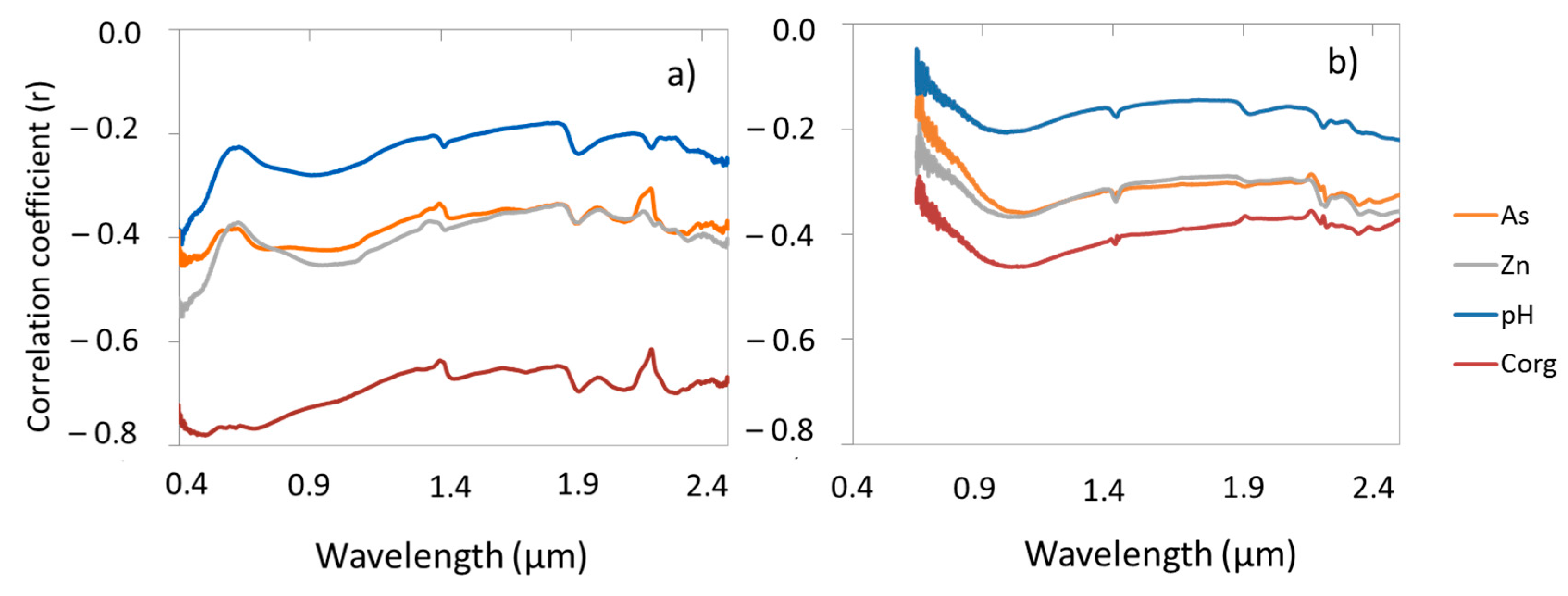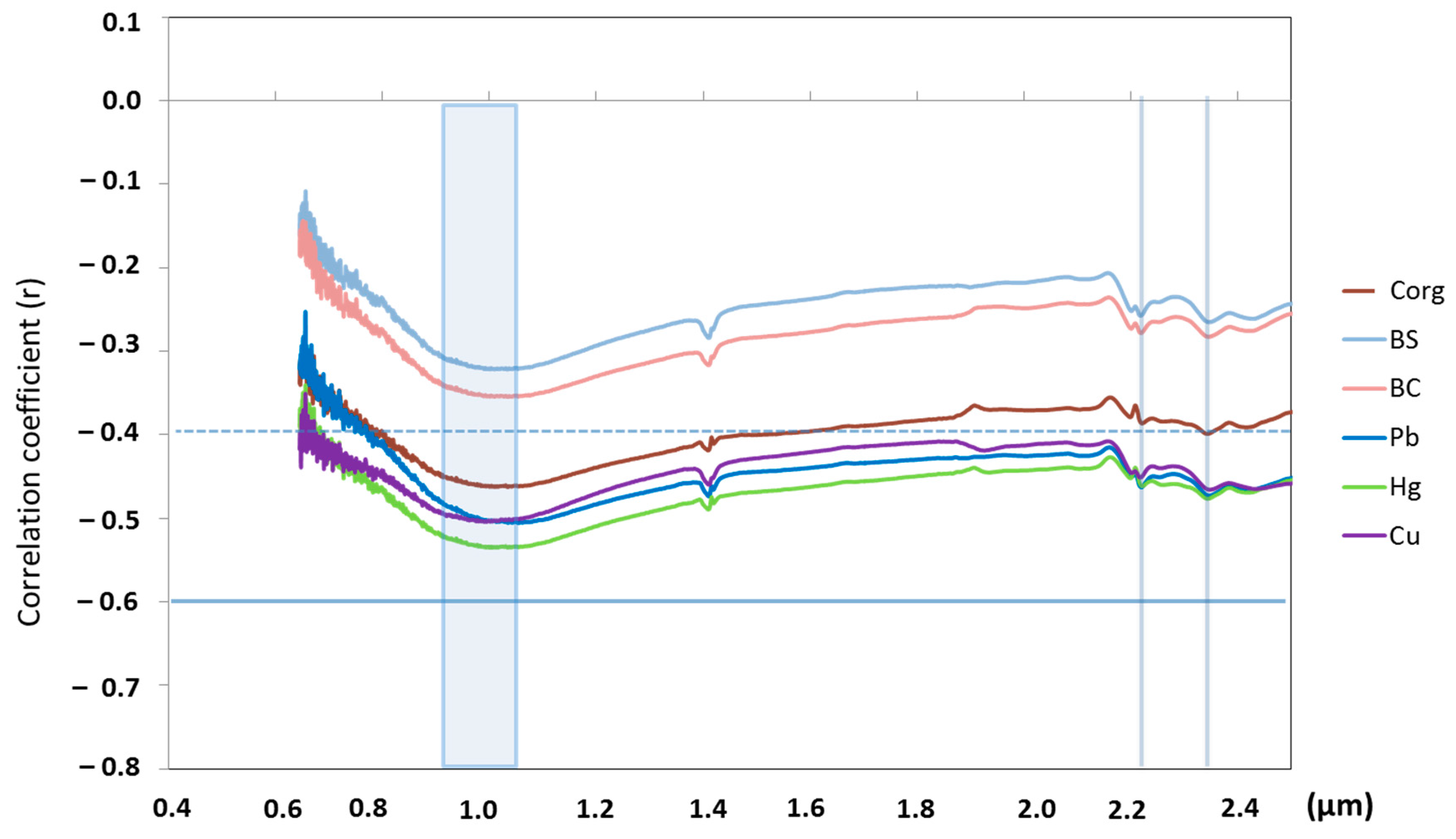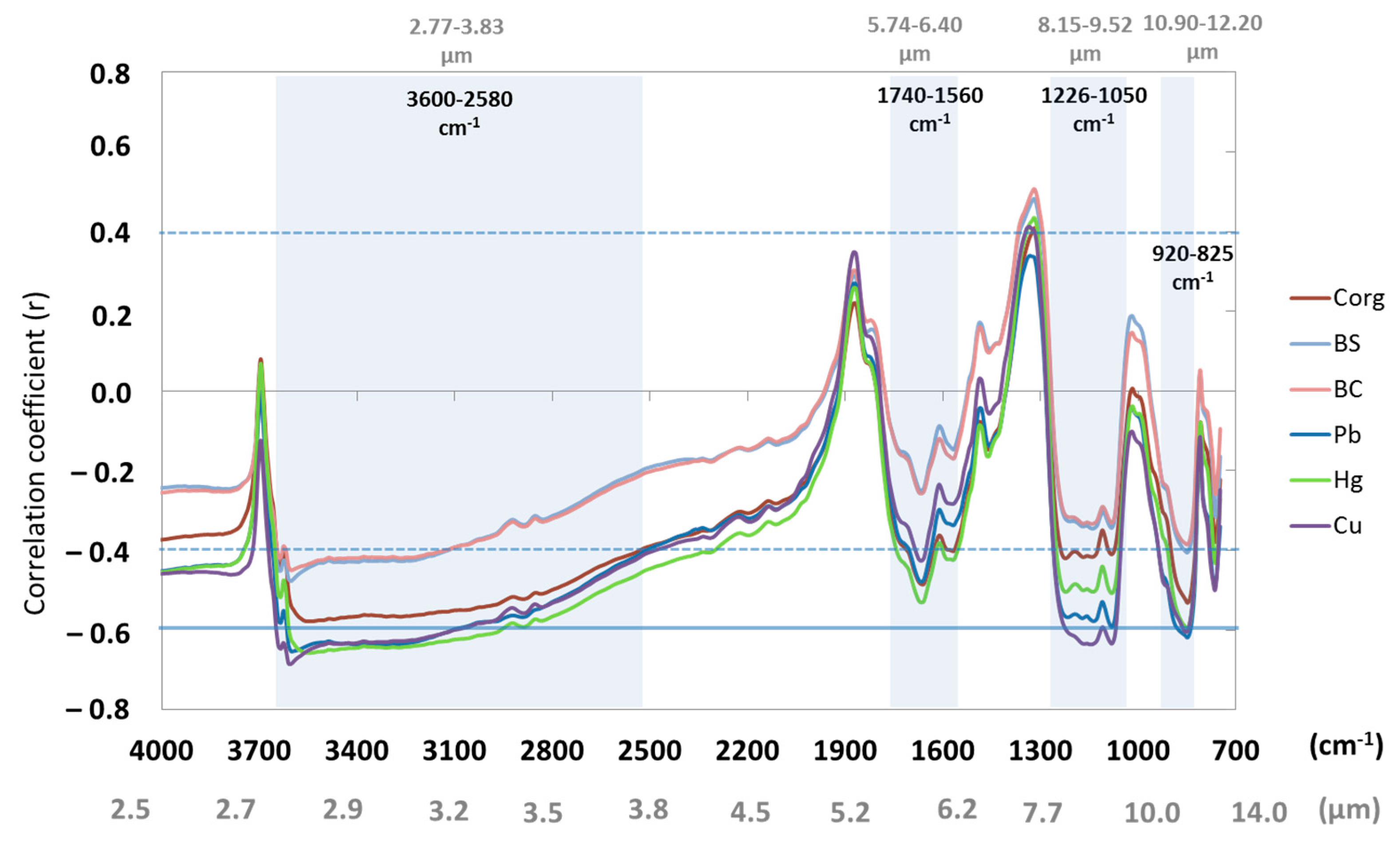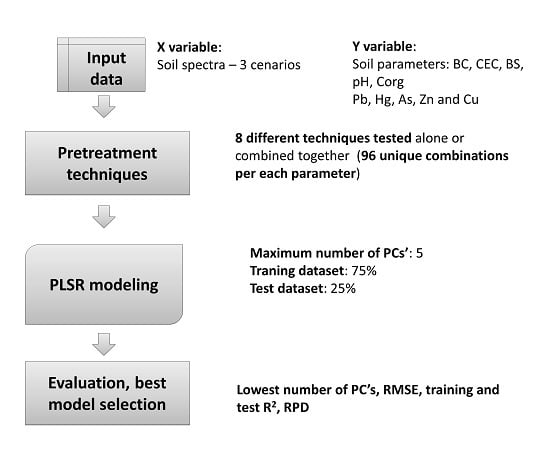1. Introduction
Soil spectroscopy has proven to be a fast, environmentally-friendly, reproducible, and repeatable analytical technique that has been increasingly used for rapid, non-destructive and cost-effective soil analyses. Spectroscopy, covering the optical (reflected solar radiation) and thermal infrared (earth surface emitted radiation) regions across the 0.4–15 µm spectral range, can be used to determine a wide range of soil properties [
1] such as organic carbon (OC) [
2], texture [
3], cationic exchange capacity (CEC) [
4], total phosphorus (P) [
5], exchangeable potassium (K) [
6], electrical conductivity (EC) [
7,
8,
9], total concentration of potential pollutant metals/metalloids [
10] and mineral content [
11,
12]. Aside from the fundamental interaction of electromagnetic radiation with matter, indirect interaction can be found and provide additional quantitative information of the soil in question [
13]. The chemical or physical phenomenon that interacts with electromagnetic radiation is termed a chromophore.
The interaction between matter and electromagnetic radiation has been studied from both the theoretical and practical points of view. The spectral information is represented by a spectrum which consists of visible as well as non-visible information to the naked eye that further, when extracted, can spotlight the material in question in both quantitative and qualitative ways. The previously mentioned spectral regions can be divided into sub-regions: visible (VIS, 0.4–0.7 µm), near infrared (NIR, 0.7–1.0 µm), shortwave infrared (SWIR, 1.0–3.0 µm), mid-wave infrared (MWIR, 3.0–7.0 µm) and longwave infrared (LWIR, 7.0–15 µm).
Analysing the spectral data can yield quantitative information about the material’s chemical composition. This is because the spectral characteristics are correlated with the direct and indirect chromophores across all regions. In the VIS and NIR regions, iron oxides (due to electronic transitions) and organic matter are the main chromophores. Across the SWIR region the main active chromophores are OH in free water and the clay mineral lattice, organic matter, carbonates and salts [
13]. In the MWIR and LWIR spectral regions, absorption features, resulting from fundamental molecular vibration modes, show additional information about soil constituents, such as Si-bearing minerals (mainly quartz and clay minerals), carbonates, organic matter and gypsum [
1,
14].
High-dimensional spectral datasets, which are typically obtained in the solid and liquid phase, are used as inputs for quantitative modelling in spectroscopy. The data mining stage for extracting a valid model requires adequate statistical analysis techniques, which are able to deal with many highly collinear spectral frequencies (predictor variables) from relatively few observations. In this regard, multivariate analysis techniques, such as Multiple Linear Regression (MLR) [
15], Principal Component Regression (PCR) and Partial Least Squares Regression (PLSR) analyses [
16], are capable of extracting reasonable models with overlapping information. Recently, different approaches have been used for spectroscopic data modelling including the artificial neural network (ANN, [
17]), support vector machine regression (SVM, [
18]) and random forests (RF) regression [
19]; however PLSR is still probably the most widely used analysis technique over all, as it is an adequate technique to handle the difficulties inherited from the interpreted overtones by extracting the response variable relevant information from the spectra, while ignoring redundant information [
12,
15,
20].
Prior to employing statistical modelling to detect the relationship between spectroscopy and the chemical properties of the material, different types of preprocessing techniques can be applied to the input spectral information (e.g., [
18,
21,
22,
23]) either to minimize the noise or normalize the input spectroscopic data. Among these methods, the most common are: smoothing techniques, spectral derivatives, transfer to a logarithmic scale or continuum removal (CR). However, a literature search revealed that a study assessing how these pretreatment techniques (employed alone or in combination) affect the final model validity has yet to be done.
Soil reflectance, in all spectral domains, has a proven capability to detect several soil properties, however it is still unclear what effects on the final models’ validity the input spectral data have (e.g., sensor specifications: spectra resolution, spectral range/ranges covered and signal to noise ratio (SNR)). Whereas most of the chemometrics work has been devoted to the reflective part of solar radiation (the optical range; VIS–NIR–SWIR) (e.g., [
24,
25,
26]), the wavelength range based on earth radiation (the thermal range; MWIR and LWIR) has been also used with quite good success [
12,
27]. Merging both ranges (optical and thermal) in chemometric analyses of soil is still not so common [
8,
12,
28] and using optical and thermal ranges together has usually been employed mainly only for organic matter modelling [
29,
30]. Therefore, the question as to whether this spectral merging would result in more valid prediction models than using just each range alone (optical vs. thermal), has yet to be sufficiently answered.
To fill these gaps in soil spectroscopic modelling, powerful statistical modelling, which can cope with many pre-treatment stages automatically to assess the best prediction models, was used and tested. This engine is termed PARACUDA
® and was designed to utilize parallel and automatic processing to build and process hundreds of diverse models in order to prevent errors or biases caused by an operator when taking the model setting decision. The following questions were asked when taking advantage of this innovative data mining approach:
To what extent does the several preprocessing method improve the modelling?
What is the contribution of the thermal infrared region (MWIR and in particular of the LWIR, as it is used in remote sensing applications) to the predictive capability of complex attributes that have no direct chromophores in the VIS–NIR–SWIR as well as MWIR and LWIR regions such as pH, base saturation and heavy metals?
What is the influence of spectrometer parameters (e.g., different spectral resolution and region coverage) on the final model results?
4. Discussion
The PARACUDA
® engine, due to its automatic processing, allowed a systematic assessment of what effects preprocessing techniques have on prediction model validity. Some preprocessing strategies have been tested before; Gholizadeh et al., 2015 [
10] achieved the best results to predict potentially toxic elements (As, Cd, Cu) using Support Vector Machine Regression (SVMR) when employing Sawitzky–Golay smoothing together with derivative analysis as a pretreatment technique. Nocita et al., 2014 [
59] tested several preprocessing techniques (CR, SNV, Sawitzky–Golay smoothing filter and the 1st and 2nd derivative) prior to employing PLSR modelling of soil organic content (SOC) when using the Lucas dataset and concluded that the Sawitzky–Golay smoothing and 1st derivative improved model prediction validity while the 1st derivative analyses improved the model’s performance for organic soil the most. In this study, the evaluation of 2880 models confirmed that the preprocessing of spectral data prior to modelling is an important step. For all of the soil attributes, the models achieved the best results when some kind of preprocessing techniques were employed (usually a combination of two or three of them). For most of the models run, smoothing (smoothing and/or final smoothing) was beneficial, especially in combination with derivative transformation (1st or 2nd derivatives).
PARACUDA
® was used to find the best estimation models of diverse soil attributes reaching the highest validity. A similar systematic approach was tested by Zhao et al., 2015 when using a processing trajectory to optimize non-systematic parameters (e.g., spectral pretreatment, latent factors and variable selection) and demonstrating better efficiency of using this approach to model the relative content of water in corn. It can be concluded that the data mining engine presented here can serve as an efficient tool to find the best prediction models. Apart from CEC, it was possible to find satisfactory predictions for the other modelled attributes (Cu considered as excellent prediction: RPD and R
2test higher than 3.0 and 0.9 respectively; C
org, BC, BS, Pb, Hg models denoted as good prediction: RPD values from 2.5–3.0 and R
2test between 0.82 and 0.90). Approximate quantitative predictions were achieved for As, Zn and pH (RPD values from 2.0 to 2.5 and R
2test between 0.66 and 0.81). The values of CEC generally characterizing the studied Norway spruce forest soil dataset were high (mean: 109.8 mmol(+)/kg, standard deviation: 32.7 mmol(+)/kg) when compared to the studies published by [
60,
61]. This can be the reason why the CEC prediction was worse (RPD = 1.48, R
2test = 0.62). For heavy metals, the results are comparable or even better than those published by [
10] when employing SVM modelling together with the 1st derivative as a pretreatment technique or by Bray et al. (2009) [
62] who used an ordinal logistic regression technique to predict Zn, Cu, Pb and Cd.
However, it needs to be noted that the results published by different groups or researchers are not consistent in the manner of defining the accuracy that can be achieved in predicting different heavy metals or other attributes which do not show any direct spectral chromophores. As they do not show any direct spectral chromophores, the mechanism of detecting them using infrared spectroscopy is thus attributed to their relationship with other soil components that have direct spectral chromophores. Therefore, for different case studies, such attributes can be predicted at different accuracy levels. For instance, heavy metals can be modelled due their associations with soil components such as: organic matter, clay minerals and Fe/Al oxides. These indirect relationships have previously been explored in pedotransfer functions (PTFs) [
28]. For instance [
63,
64] demonstrated that various PTFs can be used to predict the adsorption of metals as a function of soil carbon content, CEC and pH. Furthermore, Choe et al. (2008) [
65] proposed a binding mechanism based on the surface complex model where metals can bind to the hydroxylated mineral surface thus affecting the absorptions characteristic for Fe, Al, Mn oxides and clay minerals or organic matter. Therefore, in each case study, the results depend on the local geochemical conditions and thus the results are highly site-specific.
Due to the limited number of samples analysed (40 samples) and due to the fact that they were collected within one region, these results are also site-specific. However, it shows how the processing scheme presented here and the PARACUDA
® engine can be used to find the best prediction models as well as to get a better understanding of the geochemical properties of the samples studied. Employing statistical modelling with the aid of the system, allowed two groups or mineral associations to be defined: First group—Zn, As and pH—which can be predicted in a more accurate way using high spectral resolution spectra covering the whole optical range (ASD reflectance, 0.4–2.5 µm, Scenario 3)—and the second group—BC, BS, Pb, Hg, and Cu—for which more reliable predictions can be achieved when working with the spectrum covering shorter optical range and the thermal region (MWIR and LWIR, Scenario 1). Basically the same groups were defined when analysing the linear correlations among their chemical concentrations (
Figure 2). It has been explained that pH, as well as Zn and As, show indirect spectral indications to iron oxides, organic matter and clay minerals (
Figure 5). This relationship was also described in [
33] where multivariate statistics were employed on a chemical analysis characterizing diverse horizons within the soil profile in order to define a conceptual model for the chemical and biochemical processes taking place in the studied soil–tree system. On the other hand, the second group (BC, BS, Pb, Hg, and Cu) has a stronger relationship to phyllosilicate content together with organic component (C
org). Logically, different TPHs can be used to predict these two groups (pH, Zn, As vs. BC, BS, Pb, Hg, and Cu). It has been demonstrated that the statistical analysis of spectral assignments can add important and reliable information about the non-chromophoric properties, just as laboratory methods provide. Furthermore, the indirect relationships to diagnostic soil constituent absorption features can be analysed to help to resolve the heavy metal’s abundances and geochemical form (e.g., speciation) despite the argument some scientists have raised [
66]. This is key information for understanding the chemical behaviour of heavy metals in the environment studied.
Based on these results, it is possible to support the suggestion given by [
61], that the use of portable VIS–NIR–SWIR together with MWIR–LWIR instruments has a potential to replace many conventional techniques of soil analysis. Whereas optical field spectrometers are becoming very popular and more and more frequently used, the price for a MWIR–LWIR portable instrument is still too high and remains unaffordable for most researchers. Nonetheless, as recently also demonstrated by others [
12,
67] these results strengthen the idea that future satellite systems should be designed to work in both the optical and thermal regions (e.g., HyspIRI) in order to better evaluate heavy metals on the Earth’s surface as well as to improve the modelling capability of attributes in complex soil systems. This is also relevant for field and laboratory work.
5. Conclusions
The APA data mining engine termed PARACUDA® proved to be a powerful tool to assess the spectral performances of different spectrometers in order to achieve the best prediction models. This task cannot be achieved by the traditional and regular method that uses manual analyses and a subjective consideration by an expert/operator. For 10 soil attributes, the evaluation of 2880 models proved that preprocessing spectral data prior to modelling is an important step. For all of the attributes, the models achieving the best results employed some kind of preprocessing techniques (usually a combination of two or three of them). For most of the models run, smoothing (smoothing and/or final smoothing) was beneficial, especially in combination with derivative transformation (1st or 2nd derivatives).
Using the engine it was possible to find excellent (Cu) or good models (Corg, BC, BS, Pb, Hg) for most of the modelled attributes. Approximate quantitative predictions were achieved for As, Zn and pH. On the other hand, for the tested soils, the CEC was found to be difficult to predict even when using the PARACUDA® and being able to assess 288 different models for this soil attribute. This can be explained by the rather high CEC values characterizing this forest soil dataset.
The information from the thermal region (MWIR and LWIR) brought significant benefits to modelling base cations (BS), base saturation (BS) and organic C (Corg) as well as such heavy metals as Pb, Hg, Cu and As. On the other hand, the wider optical-range coverage (ASD spectrometer) was more beneficial for modelling pH and Zn. These two attributes showed a high affinity to iron oxides, thus, in this case, the spectra acquired by the ASD spectrometer, which covers the optical range between 0.35–2.5 µm at a high spectral resolution, resulted in better predictions. The sensitivity analyses allowed identification of the wavelengths across the optical and thermal regions that were found to be important to predict selected soil attributes. Furthermore, it has been shown how the processing scheme presented here and PARACUDA® can be used to obtain a better understanding of the geochemical properties of the samples studied (e.g., mineral associations). This is key information for understanding the chemical behaviour of heavy metals in the environment studied.
